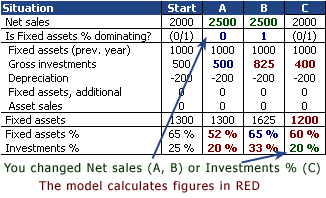Estimating fixed assets and gross investments
How Fixed assets, total is calculated?
In the company model there are two types of fixed assets: Fixed assets, total and so called Fixed assets, ordinary. Both can be found in Balance sheet assets:

Other intangible rights and Investments can be entered directly. Fixed assets, ordinary is however a bit more complicated. See the following chapters.
How ordinary fixed assets are calculated?
Fixed assets, ordinary is calculated as follows:

Fixed assets, additional and Asset sales are direct input figures. You can find them in Other estimating parameters section (Client). Normal depreciation is explained in Income statement document. Again Gross investments are a bit more complicated. They, and thus also Fixed assets, ordinary, can be estimated in three different ways.
How to estimate investments and fixed assets?
You have three possible ways to forecast Gross investments:
1. Gross investments (absolute) (can be dominating)
2. Gross investments % (of Net sales) (always dominated)
3. Fixed assets % (of Net sales) (can be dominating)
You are able to choose which parameter you would like to use as dominating. Dominating parameter remains always unchanged unless you change the parameter itself. For example if Net sales are changed, the two first of the three parameters above should change, not the third one. In Valuatum company model Gross investments % cannot be dominating but the other two can. Whether Gross investments or Fixed assets % are dominating, can be decided as follows:
In the Estimate parameters' Investments section, there is a row called Is Fixed assets % dominating?. 1 in this row means 'yes' and 0 means 'no'. When you use 0, Gross invesments become dominating.
So if you would like to use Gross invesments for the current year and Fixed assets % for the rest of the future years, the row in your model should look like this.

(Note that If you start to fill an empty model, Gross invesments are dominating for the first two years and Fixed assets % is a default after that.)
You have three possible ways to forecast Gross investments and Fixed assets, depending on which parameter is dominating
When you use Fixed assets % (dominating = 1), the model calculates:
1. Fixed assets, ordinary = Fixed assets % x Net sales
2. Gross investments = Fixed assets, ordinary - Fixed assets, ordinary (prev. year) + Normal depreciation - Fixed assets, additional + Asset sales
3. Gross investments % = Gross investments / Net sales
When you use Gross investments figures (dominating = 0), the model calculates:
1. Fixed assets, ordinary = Fixed assets, ordinary (prev. year) + Gross investments - Normal depreciation + Fixed assets, additional - Asset sales
2. Fixed assets % = Fixed assets, ordinary / Net sales
3. Gross investments % = Gross investments / Net sales
Nevertheless, as said before, you can also estimate Gross investments %. Then other two parameters are calculated afresh:
1. Gross investments = Gross investments % x Net sales
2. Fixed assets, ordinary = Fixed assets, ordinary (prev. year) + Gross investments - Normal depreciation + Fixed assets, additional - Asset sales
3. Fixed assets % = Fixed assets, ordinary / Net sales
Here is an example how the parameters can be used:

In the situations A and B Net sales has grown. Since Is Fixed assets % dominating is different in the situations, the results are also different. Gross investments are used as a dominating parameter in situation A. So Fixed assets % is calculated afresh. The opposite occurs In situation B.
In situation C Gross investments % have been inputted. Then both Fixed assets % and Gross investments are calculated afresh.
Nevertheless, no matter which parameter is dominating, you can still input any of the three parameters. The model calculates others afresh but does not change the domination.
Investments and fixed assets in history years
In history years, Gross investments are always inputted and other parameters are calculated on the basis of them.


